Compassion fatigue and secondary traumatic stress both affect caregivers but differ as compassion fatigue results from emotional exhaustion, while secondary traumatic stress arises from exposure to others' trauma. Discover the key distinctions and prevention strategies in this article.
Table of Comparison
| Aspect | Compassion Fatigue | Secondary Traumatic Stress |
|---|---|---|
| Definition | Emotional exhaustion from prolonged caregiving and empathy | Stress from exposure to others' traumatic experiences |
| Cause | Chronic exposure to patients' suffering and emotional pain | Indirect trauma through helping or witnessing trauma victims |
| Symptoms | Fatigue, irritability, detachment, reduced empathy | Intrusive thoughts, hypervigilance, avoidance, anxiety |
| Onset | Gradual over time | Can occur suddenly after traumatic exposure |
| Duration | Chronic and persistent | May be acute or chronic |
| Populations Affected | Caregivers, healthcare workers, social workers | First responders, therapists, humanitarian workers |
| Management | Self-care, counseling, workload adjustment | Trauma-focused therapy, support groups, stress reduction |
Understanding Compassion Fatigue: A Comprehensive Overview
Compassion fatigue is the gradual decline of empathy and emotional energy due to prolonged exposure to others' suffering, distinct from secondary traumatic stress, which involves acute stress reactions to indirect trauma exposure. Recognizing the signs of compassion fatigue, such as emotional exhaustion, reduced empathy, and diminished job satisfaction, is essential for maintaining your mental health in caregiving professions. Effective strategies to manage compassion fatigue include self-care, professional support, and setting emotional boundaries to sustain your compassionate engagement.
Defining Secondary Traumatic Stress: Key Concepts
Secondary Traumatic Stress (STS) occurs when You are indirectly exposed to others' trauma, leading to symptoms resembling post-traumatic stress disorder (PTSD), such as intrusive thoughts, emotional numbing, and hyperarousal. Unlike compassion fatigue, which involves emotional exhaustion from prolonged caregiving, STS specifically stems from empathetic engagement with trauma survivors. Understanding the distinct psychological impacts of STS helps professionals develop targeted coping strategies to maintain mental health and resilience.
Compassion Fatigue vs Secondary Traumatic Stress: Core Differences
Compassion fatigue and secondary traumatic stress both result from exposure to others' suffering but differ in origin and symptoms. Compassion fatigue arises from the cumulative emotional toll of caregiving, leading to feelings of exhaustion and reduced empathy, while secondary traumatic stress mimics post-traumatic stress disorder symptoms triggered by indirect exposure to trauma. Understanding these distinctions helps healthcare professionals implement targeted coping strategies to maintain emotional resilience and prevent burnout.
Shared Symptoms and Overlapping Experiences
Compassion fatigue and secondary traumatic stress share symptoms such as emotional exhaustion, irritability, and reduced empathy, reflecting the psychological toll of continuous exposure to others' trauma. Both conditions involve overlapping experiences of burnout, intrusive thoughts, and detachment from work or personal life, complicating the distinction between them. Identifying these commonalities is crucial for mental health professionals to tailor effective interventions that address the cumulative impact of caregiving roles.
Unique Risk Factors for Each Condition
Compassion fatigue primarily stems from prolonged exposure to patients' suffering, leading to emotional exhaustion and reduced empathy typical among healthcare workers and caregivers. Secondary traumatic stress arises from indirect exposure to traumatic events, often affecting therapists and emergency responders who witness clients' or victims' trauma stories. Unique risk factors for compassion fatigue include chronic workplace stress and lack of social support, while secondary traumatic stress is linked to cumulative exposure to traumatic narratives, and compassion fatigue further involves personal trauma history heightening vulnerability.
Who Is Most Vulnerable? Populations at Risk
Healthcare professionals, first responders, and social workers are most vulnerable to compassion fatigue and secondary traumatic stress due to their constant exposure to others' trauma and suffering. Caregivers of chronic illness patients and emergency personnel also face heightened risks of emotional exhaustion and burnout. Your awareness of these at-risk populations can help implement targeted support and resilience strategies effectively.
Signs and Early Warning Indicators
Signs of compassion fatigue include emotional exhaustion, reduced empathy, and feelings of helplessness, often manifesting as irritability and withdrawal. Secondary traumatic stress presents through anxiety, intrusive thoughts, and hypervigilance, reflecting trauma symptoms similar to PTSD experienced indirectly. Early warning indicators for both conditions involve persistent fatigue, difficulty concentrating, and increased cynicism, highlighting the need for timely intervention and self-care strategies in caregiving professions.
Effective Prevention Strategies and Self-Care
Effective prevention strategies for compassion fatigue, secondary traumatic stress, and burnout include regular self-assessment, establishing professional boundaries, and engaging in ongoing mental health education. Integrating self-care practices such as mindfulness, physical exercise, and seeking peer support enhances resilience and reduces emotional exhaustion. Utilizing employee assistance programs and professional counseling services can further mitigate the impact of cumulative stress on caregivers.
Treatment Approaches: Addressing Compassion Fatigue and STS
Treatment approaches for compassion fatigue and secondary traumatic stress (STS) emphasize trauma-informed care, self-care strategies, and professional support such as counseling or therapy. Evidence-based interventions include cognitive-behavioral therapy (CBT), mindfulness practices, and resilience training tailored to reduce emotional exhaustion and restore empathy. Organizational support through workload adjustments, education on trauma awareness, and peer support groups also play a crucial role in mitigating symptoms and promoting recovery.
Organizational Support and Building Resilience in Care Providers
Organizational support plays a critical role in mitigating compassion fatigue, secondary traumatic stress, and burnout by providing structured resources, training, and peer support networks that enhance care providers' resilience. Your workplace's commitment to mental health initiatives, such as regular supervision and access to counseling, directly reduces the risk of emotional exhaustion and vicarious trauma. Building resilience through mindfulness practices, stress management workshops, and fostering a culture of open communication empowers care providers to sustain compassion without compromising their well-being.

Infographic: Compassion fatigue vs secondary traumatic stress
 relatioo.com
relatioo.com